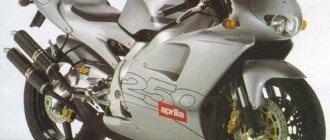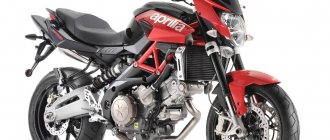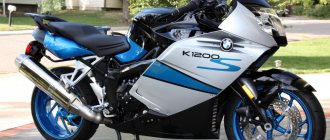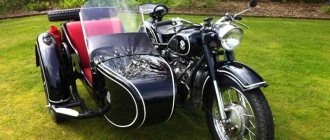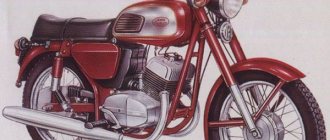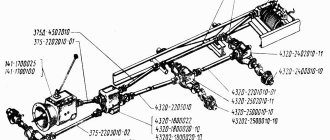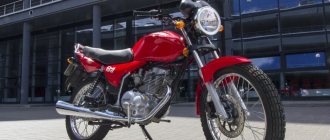Dnepr MT 10
Heavy-duty motorcycles are quite rare today, but in Soviet times they were produced in a huge range. Consequently, the Soviet motorcycle Dnepr MT 10, which is available with a sidecar included, is considered one of the best representatives. The presented model is distinguished by excellent power and the ability to transport a driver and two passengers in a stroller. Also, the dimensions of the stroller allow you to transport cargo weighing up to 260 kg. The manufacturer of this miracle is considered to be the Kiev Motorcycle Plant, but the motorcycle cannot be called completely unique. Its design and design features were borrowed from a German model produced during the Second World War.
- Huge power;
- Load capacity;
- High build quality;
- Simple design;
- Affordable price.
- Difficult to manage;
- Huge weight of 335 kg;
- High fuel consumption;
- Weak light.
As a result, the motorcycle became almost ideal for the domestic consumer; the Dnepr MT 10 could move along the road with any surface and transport heavy loads, even of a voluminous type. The main feature of the new model was the installation of reverse gear in the gearbox. Unfortunately, the motorcycle’s enormous weight of 335 kg does not allow it to move quickly, so the maximum speed is limited to 105 km/h. The MT motorcycle also had quite high fuel consumption; on average, it consumed 8 liters per 100 km. The MT 10 model has become one of the best in the Dnepr motorcycle line, the previous MT 9 model was produced since 1971, the newer Dnepr 11 began production only in 1985.
Technical characteristics of the motorcycle Dnepr MT 10
The main technical characteristics of a motorcycle are the engine performance. The engine is a four-stroke engine with two valves and two cylinders, the valves are located at the top. The new product was distinguished by the presence of good traction, which is provided by a volume of 649 cm3. Power was 36 hp. Fuel injection was made possible thanks to two K-301D carburetors.
Electricity was generated using an alternating current generator with a voltage of 12 volts. Moto Dnepr MT 10 had excellent torque, reaching 46 Nm. At maximum acceleration at high power, the bike reached up to 5,800 rpm. The kit included a rechargeable battery; if desired, you can add two batteries.
Peculiarities
On the Dnepr MT 10-36, the gaps between the locking pads and the brake drum are adjusted as wear occurs. The process is carried out by tensioning the cable using a fitting and then turning the cams on the axis. This is the first time this design has been used on heavy bikes. The advantage of such a brake is the possibility of installation on any of the previous versions of the motorcycle. Also, this type of front brake can act as a parking brake. To do this, you just need to press the brake lever on the steering wheel and secure it with a special push-button latch.
The brake element and clutch levers end in spherical knobs with a diameter of 2 cm. They serve to prevent possible injuries. The front mudguard is flanged at the end, and the passenger footrests tilt up and back at an angle of 45 degrees. A lock that locks the steering wheel in the column acts as an anti-theft device.
Appearance
The Kiev plant decided to improve the appearance of the MT 10 36 motorcycle; technical characteristics now suggested the presence of levers at the end, the passenger footrests now reclined, and union nuts appeared on the exhaust pipes. Next, the manufacturer decided to improve the existing MT 10, the modernization took place in 1985 and received a number of changes in technical terms. Today you can buy MT 10 in the following sizes:
- length 2430 mm;
- width 1680 mm;
- height 1080 mm;
- wheelbase 1500 mm;
- ground clearance 125 mm.
Externally, the Soviet heavyweight was restrained and did not have a special design; then it was not customary to install plastic and other decorative elements; the main emphasis was on quality and simplicity of design.
It was in 1985 that the motorcycle received major changes; the MT 10 engine increased power from 32 to 36 horses. Since then, the device has become officially known as the Dnepr MT 10-36. In order to improve the motorcycle, the manufacturer began to produce it in accordance with GOST, as a result, safety was significantly improved and external noise was reduced. Safety has improved in particular due to changes to the front brake, which now has two pads. The use of clamps on gas hoses helped provide additional fire protection for the motorcycle.
Now the Dnepr MT 10 with a sidecar was used with a different oil change system. It is directly added to gasoline after each refueling. This helps directly provide lubrication to the internal components. Electrical equipment receives a huge advantage; the manufacturer was able to install self-oxidizing wires, which ensure stable and durable operation of all electrical devices. Also, a special wiring system made it possible to refuse the installation of other unnecessary devices.
The gearbox is set to 4 speeds, there is a reverse speed, and a dry clutch with two discs helps ensure smooth and sensitive shifting. At that time, all Soviet motorcycles were equipped with air cooling, so the MT 10 was no exception. The suspension of the motorcycle is of quite high quality, the excellent design makes it possible to get good handling on the road and cross-country ability over uneven terrain. In particular, this is due to the presence of a sidecar, which will prevent the motorcycle from turning over at high speed.
Despite the fact that the Dnepr motorcycle with a sidecar is no longer produced, many still actively use the existing samples. They show good quality, the engine is durable and easy to maintain. If desired, you can notice many changes in appearance and design, which is called custom Dnepr MT 10.
Safety
MT 10-36 "Dnepr" is safer in terms of fire-fighting equipment. This became possible thanks to the presence of clamps on gasoline hoses. They prevent pipelines from jumping off and causing sparks. To reduce noise, a new atmospheric filter element and a more efficient muffler are used. This element is also interchangeable with analogues of other models. Only in this case it is necessary to install a new jet (180 cc/min instead of 200 cc/min). This design significantly reduces the noise of exhaust gases and prevents fuel from getting on hot parts.
The outer diameter of the muffler increased to 86 mm, and the volume increased by 1.6 times. The exhaust pipes and the internal configuration of the element have been transformed. The pipes on the cylinder are now secured with union nuts rather than clamps. This provides a tighter connection and helps remove a significant portion of the heat. After these improvements, the noise level of the unit decreased by 10 dB.
History of creation
In the post-war years, against the backdrop of general devastation, it was necessary to restore the production sector. The Kiev Motorcycle Plant was among the first to restore the production process and, despite enormous difficulties, new equipment began to roll off the assembly line.
In 1947, the Dnepr motorcycle plant began to develop new three-wheeled motor vehicles. Production expanded and after 2 years the plant’s staff was joined by hundreds of representatives from another company, which was very useful when planning the production of M-72 motorcycles. This equipment was equipped with a four-stroke two-cylinder engine. It became very popular, and therefore the decision was made to create a new, improved model, the M-53.
M-72 motorcycle with a DP machine gun in the motorcycle museum
Since 1956, production of the modernized K-750SM and M-53S motorcycles began. They were produced until 1970.
Since 1967, the plant began producing the first batch of Dnepr motorcycles. It was equipped with a two-cylinder engine with a capacity of 650 cc. cm and power 32 hp. Large production volumes gave rise to the expansion of production facilities and their re-equipment.
In 1974, a more modern model, the Dnepr MT-10, began production. After 3 years, MT-10-38 motorcycles were produced with increased engine power, they were more comfortable and practical.
The popularity of the motorcycle, including abroad, contributed to the start of production of the Dnepr 11 and Dnepr 16 motorcycles in 1985.
Popular models and their technical characteristics
The basis for the creation of the Dnepr motorcycle plant was an armored tank plant. The motor vehicles produced were not very maneuverable, but were popular among citizens. During the existence of the enterprise, various modifications of Dnepr motorcycles were produced.
The first Dnepr motorcycles appeared in 1967. The K-650 model was equipped with a powerful 650 cc engine, and thanks to the good sales dynamics of the motorcycle, its widespread production was established.
Dnepr K-650
The beginning of the 70s was marked by the release of modifications MT-9 and MT-10 . Their seats had modernized shapes, the fuel tanks and gearbox were improved.
Dnepr M-9
Since 1976, the Kiev Motorcycle Plant began producing a limited version of the MT-10 with chrome parts, which is still popular among connoisseurs of Soviet technology. This modification has become faster (up to 130 km/h), while providing reliable traction even in winter thanks to powerful studded wheels.
Since 1977, the previous version has been replaced by improved modifications MT10-36 and MT-12 .
Dnepr MT-10-36
The more popular models Dnepr 11 and Dnepr 16 had a more impressive load capacity (up to 260 kg), sidecar brakes, excellent maneuverability and speed performance. Motorcyclists still use this technology to travel around rural areas and in the city.
The Dnepr-11 model was equipped with a four-stroke two-cylinder engine, and the engine power was 38 hp. This motorcycle could reach speeds of up to 125 km/h.
Watch a video review of the Dnepr-11 motorcycle:
The Dnepr-16 motorcycle was based on the MT-10 vehicle model with additional modifications. The engine became more powerful and the maximum speed increased. The Dnepr-16 had a lower speed than the MT-11, but the sidecar wheel was equipped with a drive. The reduced speed indicators were not critical, because the motor vehicle was not considered a racing vehicle. Versatility and endurance deserved more attention.
Dnepr-16
In 1991, they released the Dnepr Solo Motorcycle (KMZ-8.157-01) - a single version, used without a sidecar, with a power of 23.5 hp. With. It was equipped with a two-cylinder engine with a capacity of 649 cc. see Speed indicators - more than 125 km/h.
Dnepr Solo
In the early 90s, there was a decrease in production volumes of Dnepr motor vehicles. However, new motorcycles are still appearing now in the form of road single motorcycles, endurros, choppers, three-wheeled heavy motorcycles and other varieties.
Qualitative indicators
The technical characteristics of the Dnepr MT 10 have many similarities with those of the MT 9, however, the motorcycle also has its own characteristics:
| Dimensions (length; width; height) | 243; 162; 108 cm |
| Weight | 335 kg |
| Speed (max) | 105 km/h |
| Fuel tank volume | 19 l. |
| Load weight | 260 kg |
| Engine | 4-stroke 2-cylinder air-cooled |
| Fuel consumption per 100 km | 8 l. with a mixed cycle |
| Engine capacity | 650 cc cm |
| Start | Kickstarter |
| Piston parameters (stroke; diameter) | 6.8; 7.8 cm |
| Engine power | 32 l. With. at 5800 rpm |
| Brakes | Shoe |
| Suspensions (front; rear) | Telescopic fork; with hydraulic shock absorber; lever on shock absorbers |
The dimensions and weight of the motorcycle are large, which is quite consistent with the class of equipment. The model’s carrying capacity is high, which determined the demand for it among rural residents, who often have to transport large and heavy loads. The powerful 650 cc engine, like that of the Dnepr MT 9, provides the driver with 32 horsepower, which is quite enough.
The responsive suspension contributes to good handling and a feeling of control over the road. The presence of a sidecar makes the design of the motorcycle more stable and reliable. The model's fuel consumption is acceptable - about 8 liters per 100 km, depending on driving style. In general, the motorcycle makes a good impression due to its performance, and even the inconspicuous and currently outdated appearance does not greatly depress the owners of this equipment.
Advantages and disadvantages of a motorcycle
The advantages of the motorcycle include:
- comfortable seat: even during long trips it is very comfortable to sit in it, your back will not become stiff and tired;
- in frosty weather the engine starts easily (if everything is prepared);
- reverse gear, which is very useful if you have a stroller;
- four-stroke engine;
- presence of thick tires;
- spare parts available for replacement;
- high power;
- cardan drive;
- unpretentiousness;
- road stability;
- simplicity of design;
- reliability, durability.
The disadvantages of the motorcycle include:
- the front brake is not enough for such a large weight of the equipment;
- poor ignition (weak spark);
- high fuel consumption;
- inconvenient brake system on the stroller;
- heavy weight;
- the engine overheats;
- the engine cylinders are low and can be torn off when traveling over rough terrain;
- noisy.
Advantages and disadvantages
The Dnepr MT 10, the characteristics of which many will find attractive, has a list of advantages and disadvantages. The advantages of the model include the following indicators:
- Good handling.
- Standard dimensions for the class.
- Reliable brakes.
- Low fuel consumption with a large gas tank.
- Huge possibilities for customization.
- Stability and balance of the structure.
The disadvantages of a motorcycle of this age are standard:
- Long mileage, amounting to more than one hundred thousand kilometers.
- Lack of new technology.
- Difficulty finding spare parts (usually the owners of such motorcycles are ready to cheaply sell some parts that are not in very good condition).
- Large mass.
- Outdated appearance, which can only be improved with tuning.
Tuning options
Due to the closure of the Kyiv Motorcycle Plant, the modernization and modification of this motorcycle equipment has been suspended. In this regard, all improvements have to be done with your own hands or contact private specialists.
Tuning areas
The exhaust system, front fork, roll bar, footrest, and windshield are most in need of replacement. Forks, footrests and other body parts are replaced with chrome-plated counterparts.
When the exhaust system is modernized, they often install nickel-plated elbows and a direct-flow muffler. Such replacements will improve engine performance and make it sound better. Some motorcyclists, instead of reverse gear, provide the device with an additional gear in order to increase the dynamics of the motorcycle.
In the video below you can see step-by-step instructions for converting a standard gearbox into a five-speed one:
The ignition system requires modification. For this purpose, the motor vehicle is equipped with an electric starter for automatic engine start and contactless ignition. The most effective effect will be replacing the engine with a new, more powerful one. Such changes will cost a significant amount because the new engine comes with additional parts and equipment.
Weaknesses and disadvantages of the Dnepr motorcycle engine
The engine of the Dnepr motorcycle is a gasoline, carburetor, two-cylinder, four-stroke, with an opposed cylinder arrangement (at an angle of 180°). The designs of engines and gearboxes of the Dnepr and Ural motorcycles are in many ways similar. Among the parts and components of power units, the following are interchangeable: carburetors, compression and oil scraper piston rings, bushings of the upper heads of connecting rods, piston pins with lock rings, valve springs and their plates. Dnieper pistons are larger and to install them in a Ural engine they must be shortened just below the lower oil scraper ring. All parts and assemblies from the clutch specification are interchangeable, with the exception of flywheels.
The gearboxes of both units have unified driven gears, speedometer drive gears, including bearings. Power units or motors and gearboxes are separate and completely interchangeable. The following components are the same in terms of electrical equipment: generator, relay-regulator, breaker with automatic advancer, ignition coil.
content .. 31 32 36 ..MOTORCYCLE GEARBOX “URAL”, “DNEPR”
On the Ural and Dnepr K-650 motorcycles, a two-way four-speed gearbox model 6204 is installed. On the Dnepr motorcycles MT9, MT10-36, MV-750M MV-650, Dnepr-12, a two-shaft four-speed gearbox with reverse gear is installed and an automatic clutch release mechanism of the MT804 model.
All models of road motorcycle gearboxes have constant gear ratios in all four forward gears: 1 - 3.6 (36/10), 2 - 2.28 (32/14), 3-1.7 (29/17) , 4-1.3 (26/20). The gear ratio is obtained by dividing the number of teeth of the driven gear (secondary shaft) by the number of teeth of the drive gear of the primary shaft.
GEARBOX OF MOTORCYCLES “URAL”, K-750 AND K-750M
The gearboxes of the Ural and K-750, K-750M, K-650 motorcycles (Fig. 4.9) of the Kyiv Motorcycle Plant are unified. Since 1980, modernized gearboxes began to be installed on Ural and Dnepr motorcycles. The cam clutches on the secondary shaft were replaced with splined ones, the external parts of the gear shift mechanism were changed into a closed crankcase cavity and isolated from dirt getting on the working surfaces. Replacing claw clutches with splined ones has significantly reduced the possibility of self-disengaging gears. Placing all parts of the switching mechanism in closed cavities significantly reduced their wear, increased the reliability and durability of the mechanism. New models of Ural motorcycle gearboxes are created on the basis of previously existing ones through repeated modernization. The gearbox model with reverse gear, produced since 1987, has much in common with the previous one.
The gearbox housing consists of: crankcase 3, front covers 1, left 11 (Fig. 4.9) and right 19 (Fig. 4.10). The crankcase and front cover are load-bearing parts that absorb the main loads during operation of the gearbox. They contain shaft supports. The left and right covers are attached to the crankcase, on which the gear shift mechanism is mounted.
Rice. 4.9. Gearbox of motorcycles “Ural”, K-750, K-750M: 1 - front crankcase cover, 2 - primary shaft; 3 - crankcase; 4 — clutch release lever; 5 — manual gear shift lever on the right crankcase cover; 6 - secondary shaft; 7 — trigger shaft; 8 — buffer plug; 9 - drain plug; 10 — lower adjusting screw of the gear shift mechanism; 11 crankcase cover; 12-pedal gear shift; 13 - plug with filler neck
Rice. 4.10. Cross section of the shafts of the Ural, K-750, K-750M motorcycles: 1 - front cover flange; 2 — oil underwater washer with a tube, 3 — cavity in the middle of the shaft; 4 - secondary shaft; 5 — adjusting shims; 6 — ball bearing; 7 — front crankcase cover; 8 — crankcase; 9 — thrust washer; 10, 13, 14, 18 - gears, respectively 4, 3.2, 1 gears; 11, 17 clutches for 3rd, 4th, 1st and 2nd gears, respectively; 12, 16 — shift fork for 3rd and 4th, 1st and 2nd gears, respectively; 15 — splined coupling; 17 — clutch for engaging first and second gears; 19 — right crankcase cover; 20, 24 — driven and driving gears of the speedometer drive, 21, 37 — cuffs; 22 — elastic coupling disk; 23 nut; 25 — slider; 26 — rubber ring; 27 - thrust bearing; 28 — roller bearing; 29 — rod tip; 30,32, 33 — crown of 1st, 2nd, 3rd gears; 31 — rod seal; 34 — 4th gear gear, 35 — key; 36 - ball bearing; 38 - input shaft; 39 — clutch release rod; 40 — cuff coupling
content .. 31 32 36 ..
Weaknesses of the Dnepr motorcycle engine
Electronic ignition. Most owners indicated that there were problems with the ignition. The motor runs unevenly and is interrupted. It turned out that it was all due to the electronic ignition, which does not work properly on this motorcycle. Cam ignition is simpler, less complex and therefore more reliable.
Checkpoint. According to some owners, the gearbox is not very reliable.
Causes and solutions to the most common faults occurring in the gearbox:
- Difficult gear shifting - often due to low oil level in the gearbox. Even a small defect can lead to gear shifting problems. Oil is responsible for lubricating all parts of the box, but it should be remembered that after some time it loses its lubricating properties. In this case, change the oil immediately.
- Grinding when shifting gears is usually the result of jamming or wear of the synchronizers - metal rings located on the main shaft of the gearbox, which are supposed to equalize the speed of rotation of the gears. It is the synchronizers that are responsible for the smooth activation of gears. Each gear has its own synchronizer.
- Noisy gearbox operation - the most common cause is worn bearings or gears. This should not be underestimated, as damage to the bearings can even lead to housing rupture.
Pistons. The weakness of the pistons is that the bottom burns out. With 5-10 minutes of engine operation with an ignition timing angle of more than 45°. When overheating, the engine begins to operate with increased noise, loss of power and does not stall when the ignition is turned off (due to overheating, glow ignition occurs). To avoid burning out the pistons, it is necessary to set the advance angle within 32-36° to the top dead center of the piston.
The most common problems with Dnepr motorcycle engines:
The engine does not start.
- The fuel supply system is clogged;
- Spark plugs have failed (carbon deposits, etc.);
- Insufficient compression in the cylinders (valve clearance, rings, etc.);
- The power supply is intermittent;
- Uneven fuel supply;
- Water in the engine or fuel;
- The jets are clogged;
- Faulty spark plugs;
- The integrity of the wiring is broken;
- The air/fuel mixture is too rich.
Engine knock.
- The ignition needs to be adjusted;
- Overheat;
- Problems with pistons and rings (loose fit, etc.).
Engine disadvantages
The Dnepr engine, unlike the Ural engine, has several critical disadvantages:
- The absence of an oil filter in the engine does not ensure cleaning of the oil in the lubrication system;
- Air cooled. Often, such cooling may not be enough to ensure the desired temperature, especially in off-road conditions.
- Prone to overheating. Requires constant monitoring of the oil level, which it likes to consume or “spit out” into the breather;
- In terms of design solutions, the Dnepr engine has a number of shortcomings. The bottom line is that, for unknown reasons, there is no oil filter in the engine; instead there is a so-called centrifuge (centrifugal filter). When centrifugal oil filters are used in car engines, they are installed after coarse oil filters, where they act as fine filters. To put it briefly and clearly, this is a round-shaped part that stands in the engine, it rotates and oil gets into it, there, according to the engineers’ idea and the laws of physics, all the dirt, by inertia, should remain on the walls of this centrifuge and filtered clean oil should be supplied further to the oil system . In practice, some dirt still gets into the lubrication system, shortening the life of the engine. Since the oil channels become clogged, in particular in the crankshaft itself, preventing oil from reaching the crankshaft liners and all this is fraught with critical breakdowns. The Dnepr’s oil system needs improvement, which is what motorcycle owners do on their own, otherwise you’ll just end up with crankshaft liners turning. Therefore, it is recommended to change the engine oil more often;
- Also, according to owners, there are manufacturing defects in the form of a gap between the front engine cover and the crankshaft. This defect leads to the removal of most of the oil into the sump; accordingly, less of it reaches the crankshaft liners;
- The gearbox does not offer excellent smoothness and precision of gear changes. You need to change gears very carefully, otherwise you can simply switch from one speed to another without noticing;
- One cannot fail to note such an important drawback in our time as the relatively high fuel consumption. If you don’t improve the power supply system, it will cost you money, because in the days of the USSR, when fuel really cost a penny, little things like gasoline consumption bothered few people;
- Requires frequent maintenance. Dnepr motorcycle engines require more frequent maintenance compared to car engines. List of work that must be performed during engine maintenance: checking and adjusting valves (thermal clearances), replacing engine oil and oil filter, monitoring the condition of spark plugs;
- Difficulty in maintenance and rather low reliability of the entire system will be the main disadvantages of this engine;
- The pressure reducing valve installed in the pump is located in the crankcase above the oil level; filling it with oil itself is not possible in case of clogging, because the valve does not fit tightly to the seat. Valve cleaning is time-consuming because it also involves disassembling the engine;
- Moreover, it has relatively small output figures: 26 and 32 horsepower, depending on the internal combustion engine model;
- In addition, the engine often suffers from the pins being too tightly seated in the piston, which leads to overheating of the cylinders and heads.
Review Dnepr MT-10-36 (1978)
I also wanted to say a little more about the Dnieper.
Usually, young padawans began (in post-Soviet times - the 90s) their motorized transport journey with something small, namely some kind of moped (Karpaty, Riga), then came Minsk or some kind of Voskhod, then there was Izh and at the end of the path PS or Java/Cheset. If someone wanted more, then they bought a car or, in rare cases, a heavy motorcycle like the Ural or Dnieper (provided that they lived to that point or were healthy enough to continue operating equipment - what can you do, youth mortality is due to inability I have sent more than one soul to other worlds to drive motorcycles).
In this regard, my path as a motorcyclist was not entirely typical. Having learned to ride a motorcycle at the age of 14 in Izha, I immediately switched to MTshnik.
Since I didn’t have a license for a motorcycle, and somehow I didn’t want to run away from the guys at high speeds (I’d beat the motorcycle and injure myself), it was decided (after scratching the turnips) to come up with a cunning plan. Namely: escape routes from the car in which the valiant servants of the striped sticks could ride have been worked out. That is, in fact, for each car a route was made and detoured that it could not overcome. Off-road is our everything!!!:):):) Since the street is not paved in any way, then we will use what we have.
For painless escape from the Volga and UAZ, there was a narrow loophole between the post and the fence, through which a Moskvich (only classic) or a Zhigul (also a classic, but already catching with mirrors) could slip through. On the opposite side of this pillar there was a track so broken by tractors that it was only possible to catch up with me in Belarus. But since traffic police do not drive tractors, this route was recognized as good and suitable. For small cars (Tavria, Zhiguli, Moskvich) there were a couple more spots that they simply could not drive through due to the terrain. To be honest, it was impossible to drive a truck there without getting stuck - the motorcycle could only go along a narrow path along the fence (almost clinging to the fence :)), drowning the stroller in a huge puddle and wading up the wheel hub of the stroller in what should be water: )
In general, I settled for a draw with the state - that is, it does not pave the road to my house, and I do not owe them anything to legitimize my right to drive this equipment.
By the way, all these escape routes were useful only once, and not for me, but for my brother.
Okay, let's move on.
This motorcycle does not like rain - the electrics began to play around and if they came into close contact with the spark plug wires, they could get an electric shock. The right spark plug flooded a couple of times and did not work well - under load it runs on one cylinder, but the dynamics are not at all the same :(
The motorcycle's carrying capacity was clearly higher than what was specified in the passport: at least it carried a whole sidecar of sand-lime brick without any problems. We also dragged trees a couple of times. It was like this: my dad gave me and my brother a task to do, namely to drag two elms from the river to the house. It doesn’t seem like it’s too far to drag - about 200 meters through the garden, but damn, what a monster you have to be to cut a dried elm tree into logs and pull them by hand. In short, I brought the motorcycle up, took the chain stronger, tied the chain on the frame (near the motorcycle itself), then on a tree. Having backed up so that 4 meters of the chain were “for acceleration”, I drove my herd of horses forward. In general, 36 horses coped with the task quite well, but it all looked, of course, quite sour - the motorcycle is dragging a whole tree :), although we had to take a detour, that is, about half a kilometer, but that’s all bullshit compared to the ruts in which Almost hit a motorcycle. In general, if the road is level, then this is an elementary task, but if there are ruts, then the tree can jerk so hard that you fall through and you can tear off the pot.
The gear selector (near the left leg) in my Dnepr was double-shouldered. By the way, this is the most optimal design for use on rough terrain. Because the single-arm one must be switched by pulling the lever up, with your toes tucked under it. And at this moment (if you are driving across a field) you could injure your foot, since there is a bunch of rubbish, stones, and pieces of iron scattered across the fields. I know a couple of people who took a long time to treat their chassis after such jokes. And you always press the two-arm lever from top to bottom: when switching to upper gears with your heel, when switching to lower gears with your toe. Safety, damn it :)
Reverse gear! This wonderful device saved me a lot of nerves and effort. It is turned on by a small lever near the right foot. To turn it on, you need to go to neutral and shift it forward by hand. In principle, after getting a little used to it, I calmly turned it on and off with my foot, so you can consider this another foot gear :) By the way, chain motorcycles did not have a reverse gear, which also greatly inferior to the Dnieper.
By the way, regarding 36 horses, the data sheet stated “at least 36 hp.” at such and such speed and 72 gasoline,” that is, half of a Zhiguli engine - for such and such a mass 
The technical book also indicated 3 (three!) ways to drive and change gears with a faulty clutch (if, for example, the cable broke on the road). True, I have never tried any of them. Because after adjusting the carburetors there was no longer any faith in the book :)
I’ll say right away: this motorcycle was used purely for going to the river, and as a small truck. Because he really carried potatoes from the garden, and corn from the field, and much more.
What I liked about this transport was its simplicity and reliability. When I saw how the owners of Izha constantly dismantled their iron horses in order to bring them to a living state, I felt sorry for them and pleased that my grandfather bought such a correct hole :)
The safety of driving on the Dnieper with a stroller is much higher than on the Izha with a stroller. This is associated with a right turn. When you turn right, the sidecar of the motorcycle tends to rise. And in the villages there are plenty of perpendicular turns. But I got used to it, even at 60 km/h I entered such turns, letting off the gas (at the exit of the turn it was about 40-45 km/h), then I just stepped on the gas a little and again 60. This won’t work on Izha - he has The stroller is light and rises at any speed, even in 2nd gear. Especially if no one is sitting there.
The Dnepr's cross-country ability is quite good, if you get used to it, and also take into account the fact that it does not drive under tension - like the Niva, it must overcome obstacles at a swoop. Well, they are not afraid to “sink” the stroller - the main thing is that the drive wheel is on good ground. It will pull the stroller in any way;)
And besides, it’s quite light - I lifted it by the rear wheel myself without any problems - you could do the same with a stroller. In general, if you get stuck, then it’s as easy as shelling pears for the two of you to stand up, pick you up by the tail, drag it to the side, back it up, and continue on your way. This all applies to black soils. On sandy soils it drives worse - because it gets stuck, here you have to drive just tight so as not to break the wheel into the axle box. Well, and most importantly, it’s better to ride through the mud with several comrades who, if necessary, will pull out the motorcycle;)
Fuel consumption, if you didn’t drive fast, was about 6-7 liters. Not fast - it's 35-40 km/h. And we didn’t really have anywhere faster - and besides, there are few roads with good surfaces and, in principle, at those distances there’s really nothing to rush - well, I’ll arrive a minute earlier, so what? I'm not late for the plane. But when you drive around the village near the courtyards, I generally had 4th gear and 25-30 km/h as standard and my right foot over the (rear) brake pedal. Simply reasoning that children playing outdoor games always run forward, but looking back can jump out of any crack in the fence, then in order to prevent any problems associated with this, I decided to simply drive quietly and leisurely. Although many people put the needle on the Dnieper (the speedometer is set to 120 km/h), many of these pilots have been in the next world for a long time, which cannot but lead to reflection. And why ruin the equipment, if you drive on the Dnieper slowly, then it will serve its owner faithfully all his life. And if you drive it both in the tail and in the mane, then in six months it will fall apart.
Summarizing the above, I can say this: the Dnepr is a good helper for a person living in a village who constantly needs to carry or transport something. And it was just a pleasure to drive it - such power is under you, you pressed the trigger a little and it went like children to school.
My impressions from this motorcycle are the best: once a year before the start of the season I changed the oil, cleaned the filter, tightened the brakes (if necessary) and... and that’s it :)
History and models of "Dnepr"
The Kiev Motorcycle Plant was created in the post-war period on the basis of an armored tank plant, which initially specialized in “heavy” products.
Therefore, it is somehow not logical to expect light enduro-style motorcycles from him. However, he managed to produce heavy motorcycle equipment quite successfully, at least in those distant times when the first Kievlyanin motorcycles or a little later the first Dnepr motorcycles rolled off the assembly line and ended up with their enthusiastic owners. However, time has passed, and Dnepr motorcycles have been produced since the 70s and are still rolling off the assembly line today, albeit in updated modifications. Someone might say that the mere fact that the plant survived the restructuring of the 90s is already a great success, but with such products it is not entirely logical to say that the plant survived - rather, it is still going through it. But let’s return to the Dnieper - the history of the MT-10 - the main motorcycle model that brought glory to the Kyiv motorcycle plant.
Motorcycle chronology
The following modifications are Dnepr MT-9
Dnepr MT-10
motorcycles appeared in 70-71. These vehicles had updated gearboxes, seats, and fuel tanks. Reverse gear has appeared. And 12-volt electrical equipment began to be installed on the MT-10.
In 1976, the Kiev motorcycle plant produced Dnepr MT-10 motorcycles of an export limited edition
for the Kremlin. Perhaps this particular modification deserves attention among today's customizers and antique lovers. Motorcycles in this series were ahead of their time in many technical characteristics. 50 hp engine and special tires made it possible to reach a speed of 130 km/h. and confidently stay on the road even in winter on slippery roads. Izhmash tried to repeat the success of the Kievites, but they were unable to create a machine of this kind.
Motorcycles "Dnepr" MTYu-Zb, MT-12
— 1977, with a 36 hp engine. replaced the MT-10, the production of which was discontinued in 1977.
However, the most significant models for the plant were the Dnepr-11
and
"Dnepr-16"
. MT-11 came with a sidecar and was equipped with 4-stroke engines of 2 cylinders with a power of 32 hp. The motorcycle was equipped with a 4-speed gearbox with reverse gear. The stroller had a brake on its wheel, and the motorcycle was additionally equipped with a parking brake. Motorcycles "Dnepr-11" came with a front telescopic fork and a pendulum suspension of the rear wheel. The maximum possible speed was 105 km/h, and the maximum load capacity was 260 kg. Dnepr 16 was distinguished by a drive to the sidecar wheel, which increased the cross-country ability of the motorcycle, and a lower speed - 95 km/h. But the main purpose of the motorcycle - transporting small loads and driving through rural areas - did not require high speed characteristics.
In 1991, the production of single motorcycles with a volume of 650 cubic meters began. But this is no longer history, but a harsh reality. More about it in the form of reviews a little later.
Today, the Kiev Motorcycle Plant is the only enterprise in Ukraine producing heavy motorcycles. About 15 modifications of Dnepr motorcycles come off the assembly line - road singles, choppers, enduro three-wheeled cargo motorcycles, etc. However, they are not too far removed from the old models and are purchased more out of needs and capabilities than out of desire.
About MT10-36 1980 release
I’ll write a little poetry about how I bought a second motorcycle. After I learned that the owner of my cacique had died, I almost fell into despair. After all, he died a week before I bought the motorcycle. The seller spread his hands. Gee. Money and time are wasted, the chances of getting the paperwork done are slim. Summer is just around the corner, I really want to go for a ride. I had a crazy idea to buy any boxer at the docks and twist its nameplate onto a cacique or something like that. I found a good option: MT10-36 with a mileage of 2700 km.
The owner assured that the motorcycle was owned by his grandfather, whose motorcycle stood in the garage on bricks for about 25 years. Then the grandfather sold the motorcycle and also left for another world. We rode the motorcycle a bit and had minimal maintenance. The lights were on. The motorcycle is in its original paint. The only collective farm is two ignition coils instead of the original one. When I asked “why,” the seller just shrugged his shoulders. The stroller wheel was a Kasiv one with a narrow hub. I changed my mind about changing the nameplates, let there be two motorcycles.
I left a deposit and went home. It's March. I hooked up the trailer and set off to pick up the motorcycle. 240 km one way. Before loading, we decided to check once again how the motorcycle rides. We poured gasoline and oil into the tank (a mixture for a chainsaw) and the motorcycle surprisingly started on the second kick. We loaded it, went to the traffic police, and formalized the purchase and sale. By the way, the day turned out to be surprisingly snowy. Considering the snow and the load, we had to move slowly.
I arrived at the garage after dark. Now I have two motorcycles and both with sidecars. And I myself only sat behind the wheel of a motorcycle in motorcycle school. I only had an idea about driving a stroller from the forums.
A week later, I loaded the MT again and went to register with the traffic police. A week later I received a registration certificate and a license plate. In the data sheet the frame number is indicated B/N. For minimal preparation for trips, I purchased three petroshin tires 3.75/19, a battery, wires, oils, lithol. Got the wiring in order.
I renewed the grease in the hub bearings, adjusted the brakes, and replaced the tires.
Changed the oil, washed the carburetors and air filter. Otherwise the motorcycle was in reasonable condition. One carburetor had a float leak, I replaced it. He held out the pins. I tore off the thread on one nut, which surprised me by the way. I didn't put in that much effort there. I had to buy a stud for a nut. Well, that's all. It's time to leave. On a warm summer evening, I left the garage and set off on a journey that was six kilometers one way along one of the busiest streets in the city. Surprisingly, the motorcycle did not let me down. I adjusted the high idle right at the traffic light.
My next trip was already 25 km one way, and even on the highway! Of course, a motorcycle on the road gives you a feeling of freedom that is incomparable to anything else. And you can throw a bunch of rags, a bag, a can of oil, keys into the stroller and cover everything beautifully with an awning. What a cool stroller!
I have no desire to make changes to a forty-year-old design; I don’t see the point in it. In my opinion, the value of such technology lies precisely in its original form. This way we can get an idea of the technology of those years and notice some interesting things. Especially the viewer from the outside. This is my personal position. If there is enough time and money before the start of the season, the plan is to replace everything rubber with new ones, galvanize the fasteners, and repaint them. As well as troubleshooting the engine and replacing gaskets.

